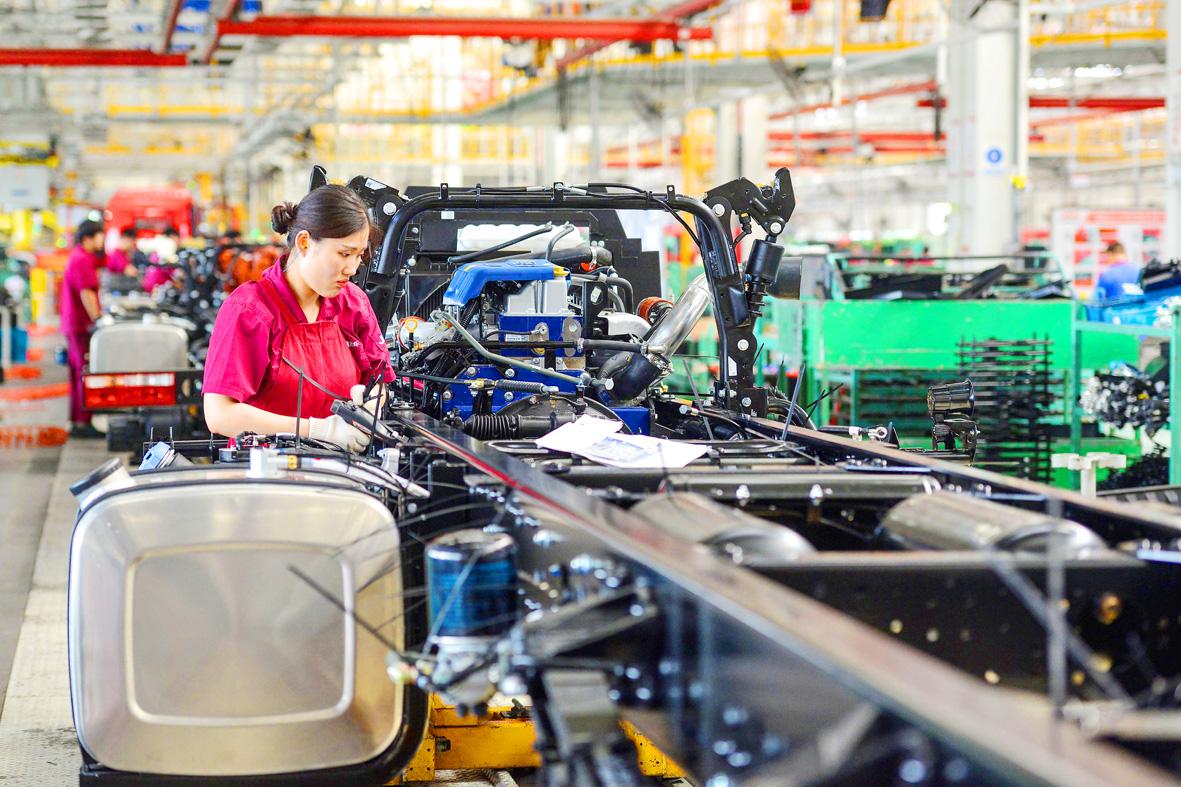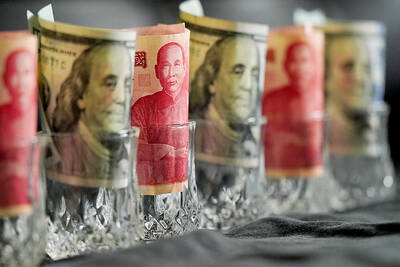China saw forecast-beating economic growth in the second quarter after a record contraction in the previous three months, as businesses cautiously returned to normality following lockdowns due to the COVID-19 pandemic.
The figures released yesterday follow a string of data showing the world’s No. 2 economy slowly emerging from the outbreak and should provide hope to other governments looking to get back on track.
GDP expanded 3.2 percent in the April-to-June period, the Chinese National Bureau of Statistics said, smashing expectations and a massive improvement on the 6.8 percent contraction in the first quarter.

Photo: AFP
However, in a sign that full recovery could take time, retail sales — a key indicator of consumer sentiment in China — fell short of forecasts, shrinking 1.8 percent year-on-year last month.
That suggests people remain reticent about going out to spend even as the virus appears largely under control in China.
The retail sector has taken on an increasingly crucial role in China’s economy as leaders look for consumers, rather than trade and investment, to drive growth.
There is an even greater need for a pickup in domestic consumption as China’s external demand weakens, but it is easier to normalize supply than demand, AxiCorp strategist Stephen Innes said.
Louis Kuijs of Oxford Economics said that household consumption remains the “weakest link” among indicators, although China’s economic upturn is expected to continue in the second half of this year.
Economists warn of uncertainty ahead owing to an uneven recovery — growth in infrastructure investment has rebounded, but private fixed-asset investment and retail sales remained weak.
Last quarter’s growth reading, while beating the 1.3 percent growth tipped in an Agence France-Presse poll of analysts, is still among China’s lowest quarterly growth rates on record.
The economy contracted 1.6 percent year-on-year in the first six months, the bureau said, while the urban unemployment rate dipped to 5.7 percent last month, from 5.9 percent a month earlier.
Unemployment is a closely watched marker, with nearly 9 million graduates expected to enter an uncertain labor market this year and analysts saying the actual jobless rate is likely higher, especially when the huge floating population of migrant workers is taken into account.
Industrial production grew 4.8 percent last month, in line with expectations and up from 4.4 percent in May.
Bureau spokeswoman Liu Aihua (劉愛華) told a news conference that China’s economy “demonstrated a momentum of restorative growth and gradual recovery.”
However, with the pandemic still ravaging many of China’s key trading partners, national economic recovery was “still under pressure,” Liu said.
China is expected to be the only major economy to see growth this year, being the first hit by the virus and to bounce back. However, economists warn that official Chinese economic figures should be taken with a grain of salt, with longstanding suspicions that growth data are massaged upward for political reasons by the Chinese Communist Party, which has based its legitimacy on delivering continued prosperity.
“Is it too good to be true?” ING Bank NV chief economist for Greater China Iris Pang (彭藹嬈) asked, adding that more data were needed.
She also pointed to risks down the road, including trade and tech tensions with other major economies, and major flooding in parts of China.

The US dollar was trading at NT$29.7 at 10am today on the Taipei Foreign Exchange, as the New Taiwan dollar gained NT$1.364 from the previous close last week. The NT dollar continued to rise today, after surging 3.07 percent on Friday. After opening at NT$30.91, the NT dollar gained more than NT$1 in just 15 minutes, briefly passing the NT$30 mark. Before the US Department of the Treasury's semi-annual currency report came out, expectations that the NT dollar would keep rising were already building. The NT dollar on Friday closed at NT$31.064, up by NT$0.953 — a 3.07 percent single-day gain. Today,

‘SHORT TERM’: The local currency would likely remain strong in the near term, driven by anticipated US trade pressure, capital inflows and expectations of a US Fed rate cut The US dollar is expected to fall below NT$30 in the near term, as traders anticipate increased pressure from Washington for Taiwan to allow the New Taiwan dollar to appreciate, Cathay United Bank (國泰世華銀行) chief economist Lin Chi-chao (林啟超) said. Following a sharp drop in the greenback against the NT dollar on Friday, Lin told the Central News Agency that the local currency is likely to remain strong in the short term, driven in part by market psychology surrounding anticipated US policy pressure. On Friday, the US dollar fell NT$0.953, or 3.07 percent, closing at NT$31.064 — its lowest level since Jan.

The Financial Supervisory Commission (FSC) yesterday met with some of the nation’s largest insurance companies as a skyrocketing New Taiwan dollar piles pressure on their hundreds of billions of dollars in US bond investments. The commission has asked some life insurance firms, among the biggest Asian holders of US debt, to discuss how the rapidly strengthening NT dollar has impacted their operations, people familiar with the matter said. The meeting took place as the NT dollar jumped as much as 5 percent yesterday, its biggest intraday gain in more than three decades. The local currency surged as exporters rushed to

PRESSURE EXPECTED: The appreciation of the NT dollar reflected expectations that Washington would press Taiwan to boost its currency against the US dollar, dealers said Taiwan’s export-oriented semiconductor and auto part manufacturers are expecting their margins to be affected by large foreign exchange losses as the New Taiwan dollar continued to appreciate sharply against the US dollar yesterday. Among major semiconductor manufacturers, ASE Technology Holding Co (日月光), the world’s largest integrated circuit (IC) packaging and testing services provider, said that whenever the NT dollar rises NT$1 against the greenback, its gross margin is cut by about 1.5 percent. The NT dollar traded as strong as NT$29.59 per US dollar before trimming gains to close NT$0.919, or 2.96 percent, higher at NT$30.145 yesterday in Taipei trading